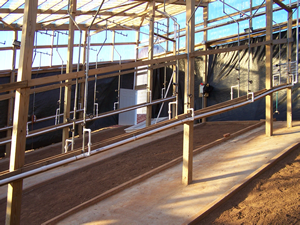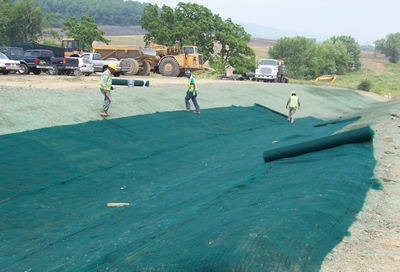In this two-part series, Katie Westfall writes about the positive impact the National Transportation Product Evaluation Program (NTPEP) and the implementation of large-scale (or full-scale) erosion and sediment control testing are having on the field. This article has been updated from its initial version in September 2011. A link to Part II is provided at the end of this article.
**
 |
Erosion, sediment and stormwater has an unquestionably critical impact on the quality of our environment. The United States Environmental Protection Agency’s (EPA) implementation of stormwater protection plans for any land disturbance of 1 acre or greater stresses the tremendous responsibility for environmental protection. This mandate affects virtually every construction effort that disturbs soil. Furthermore, revisions to related effluent guidelines are ongoing. Originally scheduled to be implemented beginning in August 2011 but stayed temporarily while additional data is being gathered, the revisions will intensify the need for construction site erosion and sediment controls. The EPA has estimated that these new rules may cost more than $900 million annually for site control needs.
Commonly, the erosion and sediment controls that are selected are referred to as “best management practices.” BMPs are cited ubiquitously in project specifications and product literature. But what puts the “B” in BMP?
BMP is an extremely broad term, extending well-beyond any particular type of product or activity. In erosion control, it can refer to hydraulically applied products, rolled products, materials with natural or synthetic components, etc. BMP can refer to products or systems, both traditional and alternative. BMP can even refer to how a product or system is installed or monitored.
For the ever-expanding erosion and sediment control products industry, this broad use of “BMP” has presented a problem to product and system specifiers. Historically, there has been a lack of generally accepted methods to define performance of these products, making it difficult to demonstrate definitively why a particular BMP might actually be the “best” in comparison to alternative management practices. Thus, users have lacked an objective means to specify performance. This is not in line with how other construction products are vetted, approved and purchased.
The good news is that this problem may be going away. The implementation of standardized, repeatable large-scale performance tests for erosion and sediment control products is now well underway. These tests provide a long-needed means to perform “apples-to-apples” comparisons of the various technologies in different applications, and they offer data to show how the unique characteristics of these products translate into actual field performance.
Important to this development in the field is the work of the independent and influential National Transportation Product Evaluation Program (NTPEP), which has now incorporated large-scale testing performance data into its system. The objective process offered by NTPEP is a key factor in making the selection of BMPs more of a science, and providing the quantitative evidence needed to determine which product or practice truly is “best” for a given application. The initial focus of NTPEP has been on rolled erosion control products (RECPs). More recently, NTPEP has been developing plans to include hydraulically-applied erosion control products (HECPs). And, hopefully in the not too distant future, NTPEP will be able to incorporate sediment retention devices (SRDs).
GETTING HERE
 |
Since the early 1990s, the Erosion Control Technology Council (ECTC), an association of manufacturers, has played a key role in improving the state of practice in erosion and sediment control. ECTC has strongly supported the development of standard test methods as it has worked to encourage a free, but fair, marketplace for its members. As a testament to ECTC efforts, standardized test results and performance information has rightfully become expected by the users of erosion and sediment control materials. Test data is a valuable tool which helps to ensure fair competition by improving product understanding, selection, installation, and most importantly success. ECTC has been vital to bringing test data to light.
In the 1990s, the Council’s work included providing the essential funding to independently establish appropriate index and bench-scale tests. Those tests have since provided the main source of erosion and sediment control product comparative data. Index tests are relatively simple tests that manufacturers use routinely to control product quality. They also give users, such as land developers and government agencies, a way to verify product conformance to project specifications. Relevant index material properties include thickness, water absorption, and mass per unit area. Bench-scale performance tests offer a low-cost, quick way for companies or independent laboratories to test product bench-scale performance under “indexed” standard conditions. While not equal to large-scale field performance testing, these tests essentially give manufacturers an estimate of expected product behavior, particularly in relation, for example, to how a variation in a product’s components or construction might impact expected field performance under certain installation conditions, against certain flows, on a particular slope angle, etc.
NTPEP, meanwhile, set about minimizing the duplication of product pre-qualification efforts by state DOTs. The organization created a single database of material test results–a move that has made product specification more efficient, clearer, and ultimately more economical for NTPEP’s members. Materials submitted to NTPEP undergo a standardized suite of tests performed by an independent third-party NTPEP laboratory, the results of which are available online as public record. DOTs can, as a result, use that data (in full or in part) for the creation of their own approved product lists (APLs) and specifications for work performed in their states.
The NTPEP program:
- Relieves states of the economic burden relating to the construction, staffing and maintenance of a facility specifically to test and approve products
- Provides consistent testing practices across a wide range of materials
- Provides a single submission process for the manufacturer, the
reby reducing the cost of doing business in each state while improving competition in each marketplace
NTPEP’s work has involved and continues to involve a large array of traffic safety, construction and maintenance issues and products, from crack sealants to flashing arrow panels to geotextiles and geogrids. The NTPEP focus is on the development and delivery of meaningful product evaluation data.
For erosion and sediment control, ECTC and NTPEP’s independent efforts jointly nudged the industry toward greater reliance on objective quantitative measurements and generic material specifications.
Still, index and bench-scale performance tests have not been sufficient, especially in this rapidly expanding field of engineered products and manufacturers of various levels of sophistication. These tests provide essential details on material and manufacturing quality and basic characteristics regarding performance; but they offer only an impression of actual, full-scale performance. Thus, specifications, cost/benefit analyses, Approved Product Lists, and other attempts at product comparisons are incomplete if only based on index and bench-scale testing. This is where standardized large-scale performance testing becomes important.
Read Part II of this two-part series
Katie Westfall is a writer based near Orlando, Florida.











